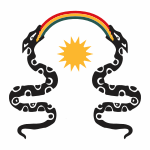Mama Killa
Mama Quilla(Quechuamamakillalit."Mother Moon",[1]Hispanicized spellingMama Quilla), inInca mythologyandreligion,was the third power andgoddess of the moon.She was the older sister and wife ofInti,daughter ofViracochaand mother ofManco CápacandMama Uqllu(Mama Ocllo),mythical founders of theIncaempire and culture. She was the goddess of marriage and themenstrual cycle,and considered a defender of women. She was also important for the Incacalendar.
Myths surrounding Mama Quilla include that she cried tears of silver and thatlunar eclipseswere caused when she was being attacked by an animal. She was envisaged in the form of a beautiful woman and her temples were served by dedicated priestesses.
It is possible that word quilla is a borrowing fromPuquina languageexplaining thus why genetically unrelated languages such as Quechua,AymaraandMapuchehave similar words for the Moon.[2]Similitudes are not only linguistic but also symbolically as inMapucheand Central Andean cosmology the Moon (Quilla/Cuyen) and the Sun (Inti/Antu) are spouses.[3]
Beliefs
[edit]Mama Quilla was known as "Mother Moon", and was goddess of the moon.[4]According to FatherBernabé Cobo,writing in the mid-sixteenth century, the Moon was worshipped because of her "admirable beauty" and the "benefits she bestows upon the world".[5]She was important for calculating the passage of time and the calendar, because many rituals were based upon thelunar calendarand adjusted to match thesolar year.[4]She also oversaw marriage, women'smenstrual cycles[6]and was deemed the protector of women in general.[7]
Myths surrounding Mama Quilla
[edit]One myth surrounding the Moon was to account for the "dark spots";it was believed that a fox fell in love with Mama Quilla because of her beauty, but when he rose into the sky, she squeezed him against her, producing the patches.[4]The Incas would fearlunar eclipsesas they believed that during the eclipse, an animal (possibly amountain lion[5]or serpent[5][7]) was attacking Mama Killa. Consequently, people would attempt to scare away the animal by throwing weapons, gesturing and making as much noise as possible. They believed that if the animal achieved its aim, then the world would be left in darkness. This tradition continued after the Incas had been converted toCatholicismby theConquistadors,which the Spanish used to their advantage. The natives showed the Spanish great respect when they found that they were able to predict when the eclipses would occur.[5]Mama Quilla was also believed to cry tears of silver.
Relations
[edit]Mama Killa was generally the third deity in theInca pantheon,afterInti(god of the sun) and Illapu (god of thunder),[5]but was viewed as more important than Inti by some coastal communities, including by theChimú.[4]Relatives of Mama Killa include her younger brother and husband Inti, god of the sun, and her childrenManco Cápac,first ruler of the Incas, and Mama Ocllo, Manco Cápac's older sister and wife.[7]After theIchma,nominally of theChimú Empire,joined the Inca empire, she also became the mother of their deityPacha Kamaq.[8]Mama Killa's mother was said to beViracocha.
Symbology and temples
[edit]Mama Killa had her own temple inCusco,served by priestesses dedicated to her.[4]She was imagined as a human female,[4]and images of her included a silver disc covering an entire wall.[7]
See also
[edit]Sources
[edit]- D'Altroy, T.N. (2002)The Incas,Blackwell Publishing: Oxford.ISBN978-0-631-17677-0.
- Pugh, HelenIntrepid Dudettes of the Inca Empire(2020)ISBN9781005592318
References
[edit]- ^Teofilo Laime Ajacopa, Diccionario Bilingüe Iskay simipi yuyayk'ancha, La Paz, 2007 (Quechua–Spanish dictionary)
- ^Moulian, Rodrígo;Catrileo, María;Landeo, Pablo (2015)."Afines quechua en el vocabulario mapuche de Luis de Valdivia"[Akins Quechua words in the Mapuche vocabulary of Luis de Valdivia].Revista de lingüística teórica y aplicada(in Spanish).53(2): 73–96.doi:10.4067/S0718-48832015000200004.
- ^Moulian, Rodrigo;Catrileo, María;Hasler, Felipe (2018)."Correlatos en las constelaciones semióticas del sol y de la luna en las áreas centro y sur andinas"[Correspondence of semiotic sun and moon constellations in the central and southern andes].Boletín del Museo Chileno de Arte Precolombino(in Spanish).23(2): 121–141.doi:10.4067/S0718-68942018000300121.
- ^abcdefD'Altroy, p. 148.
- ^abcdeCobo, Bernabé (1990) [1653].Inca Religion and Customs.Austin, Texas:University of Texas Press.pp.29–30.ISBN9780292738546.
- ^"Pre-Columbian civilizations".Encyclopædia Britannica Online.2008.Retrieved23 March2008.
- ^abcdConway, D. J. (1995).Moon Magick: Myth & Magick, Crafts & Recipes, Rituals & Spells.Llewellyn Worldwide.p. 148.ISBN978-1-56718-167-8.
- ^Lanning, Edward (1968).Peru Before the Incas.Prentice Hall.ISBN978-0-13-661595-8.

